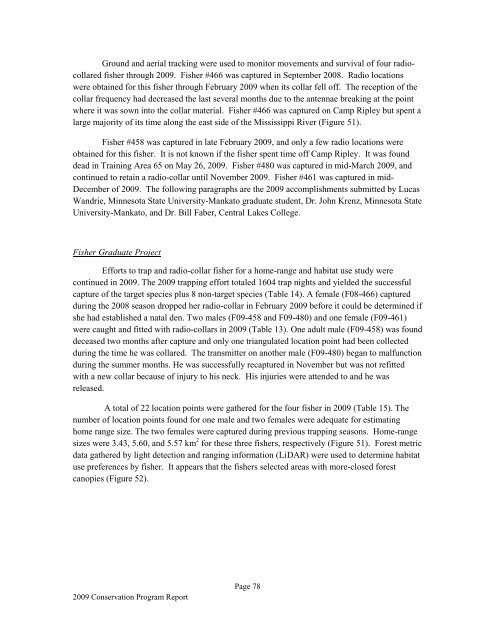camp ripley and arden hills minnesota army national guard training ...
camp ripley and arden hills minnesota army national guard training ...
camp ripley and arden hills minnesota army national guard training ...
You also want an ePaper? Increase the reach of your titles
YUMPU automatically turns print PDFs into web optimized ePapers that Google loves.
Ground <strong>and</strong> aerial tracking were used to monitor movements <strong>and</strong> survival of four radiocollared<br />
fisher through 2009. Fisher #466 was captured in September 2008. Radio locations<br />
were obtained for this fisher through February 2009 when its collar fell off. The reception of the<br />
collar frequency had decreased the last several months due to the antennae breaking at the point<br />
where it was sown into the collar material. Fisher #466 was captured on Camp Ripley but spent a<br />
large majority of its time along the east side of the Mississippi River (Figure 51).<br />
Fisher #458 was captured in late February 2009, <strong>and</strong> only a few radio locations were<br />
obtained for this fisher. It is not known if the fisher spent time off Camp Ripley. It was found<br />
dead in Training Area 65 on May 26, 2009. Fisher #480 was captured in mid-March 2009, <strong>and</strong><br />
continued to retain a radio-collar until November 2009. Fisher #461 was captured in mid-<br />
December of 2009. The following paragraphs are the 2009 accomplishments submitted by Lucas<br />
W<strong>and</strong>rie, Minnesota State University-Mankato graduate student, Dr. John Krenz, Minnesota State<br />
University-Mankato, <strong>and</strong> Dr. Bill Faber, Central Lakes College.<br />
Fisher Graduate Project<br />
Efforts to trap <strong>and</strong> radio-collar fisher for a home-range <strong>and</strong> habitat use study were<br />
continued in 2009. The 2009 trapping effort totaled 1604 trap nights <strong>and</strong> yielded the successful<br />
capture of the target species plus 8 non-target species (Table 14). A female (F08-466) captured<br />
during the 2008 season dropped her radio-collar in February 2009 before it could be determined if<br />
she had established a natal den. Two males (F09-458 <strong>and</strong> F09-480) <strong>and</strong> one female (F09-461)<br />
were caught <strong>and</strong> fitted with radio-collars in 2009 (Table 13). One adult male (F09-458) was found<br />
deceased two months after capture <strong>and</strong> only one triangulated location point had been collected<br />
during the time he was collared. The transmitter on another male (F09-480) began to malfunction<br />
during the summer months. He was successfully recaptured in November but was not refitted<br />
with a new collar because of injury to his neck. His injuries were attended to <strong>and</strong> he was<br />
released.<br />
A total of 22 location points were gathered for the four fisher in 2009 (Table 15). The<br />
number of location points found for one male <strong>and</strong> two females were adequate for estimating<br />
home range size. The two females were captured during previous trapping seasons. Home-range<br />
sizes were 3.43, 5.60, <strong>and</strong> 5.57 km 2 for these three fishers, respectively (Figure 51). Forest metric<br />
data gathered by light detection <strong>and</strong> ranging information (LiDAR) were used to determine habitat<br />
use preferences by fisher. It appears that the fishers selected areas with more-closed forest<br />
canopies (Figure 52).<br />
2009 Conservation Program Report<br />
Page 78
















